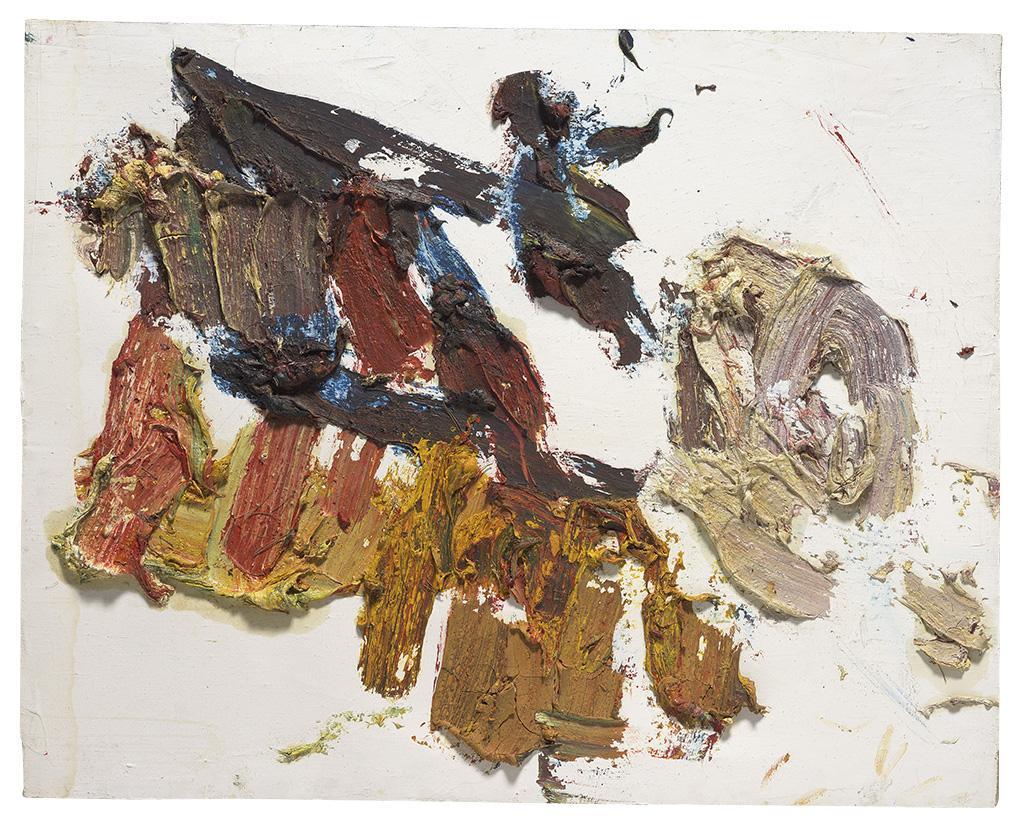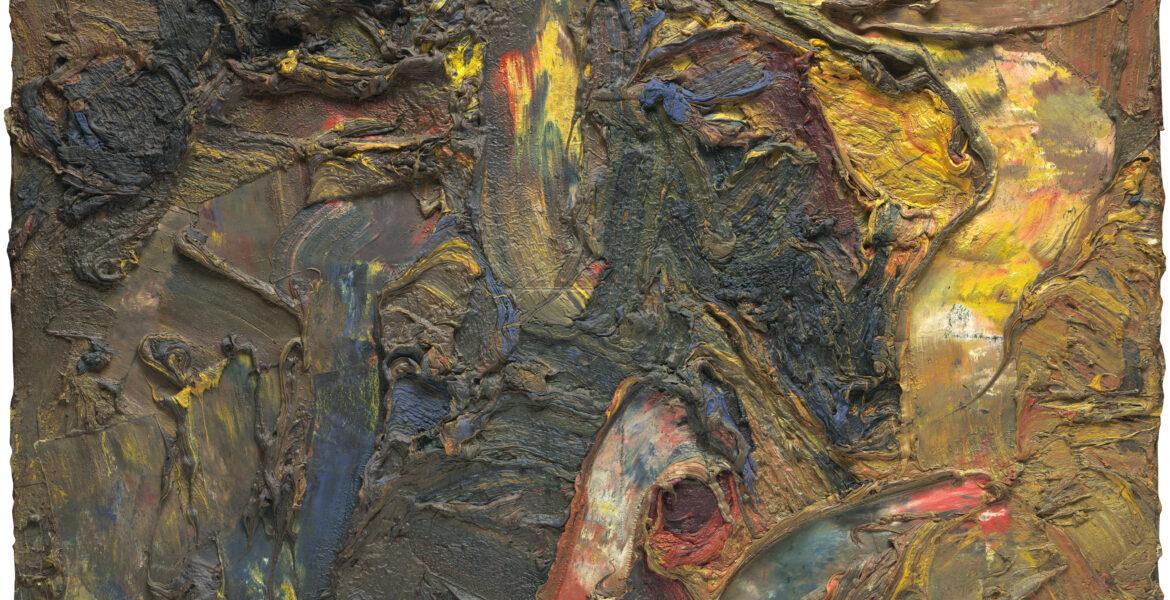Franz Grabmayr is occupying a unique spot in Austria’s art history. He painted with conviction when painting was declared dead and while he greatly influenced several generations of artists like the “Neue Wilde”, he himself refrained from the art business entirely.
by Sarah Heftberger
Born in the picturesque village Pfaffenberg near Obervellach, Carinthia on April 19, 1927 as the youngest of three children, he grew up on a remote mountain farm. He was very close to his sister Resi and spent his childhood surrounded by nature. “The lack of materialistic things on one hand and the incredible richness of nature on the other shaped him and throughout his life, he was always searching for exactly that”, his son Jakob explains in an interview with SOCIETY.
Grabmayr first started to paint watercolours when he was 12, his prime source of inspiration being nature. Yet, the results of his first paintings did not satisfy him, which is why he destroyed them – something he later regretted: “I tore them all up. I worked in a very free and dynamic way. I would love to have those drawings today […]”, he stated in one of his rare interviews with the Austrian historian and journalist Wolfgang Hingst.
After attending the construction trade school in Villach and later completing a teacher training, he started teaching mathematics, geometrical drawing and boys handicrafts classes at the newly founded St. Jakob im Rosental high school. The creative atmosphere there had a big impact on him and inspired him to start painting again. He began to capture the view from his attic window across rose valley in the mornings: A pivotal moment and the starting point of his career as a painter, as his son remembers him saying.
As fate would have it, Grabmayr was then asked to swap jobs – from his post in St. Jakob to Vienna, which he agreed to. From then on, he held classes in the morning and studied at the Academy of Fine Arts as a student trainee in the afternoon.

He fully immersed in his art and spent every spare hour painting or studying other artists, especially Cézanne. “Cézanne helped me with the spiritual approach in transforming nature into painting. I always said that a picture is a spiritual dimension in the wall. That’s what it is about”. Furthermore, he felt a strong connection with Austrian artists Herbert Boeckl – who was his professor at the academy – and Oskar Kokoschka, amongst others.
During a trip to Paris in 1956, he met his future wife Ingrid in front of the Mona Lisa at Louvre. They married only a few months later and in 1957, their first son Thomas was born. From 1962 onwards – encouraged by his wife – he quit his teaching job and devoted himself entirely to art. In 1964, he received his degree from the Academy.
Between 1964 and 1972, the Grabmayr family lived in Schloss Rosenau, a castle damaged by war – there was no running water and electricity was provided only via an extension cable. But the conditions to paint were perfect for the artist: Bright and spacious rooms and above all, an unobstructed view over the hilly landscape of Waldviertel. His “Grüne Bilder” and the sand quarry paintings were created during that time. He spent five years painting in this sand quarry and there was no other motif that inspired him more at that time.
In 1970 – the same year his second son Jakob was born – he spent six months in Venice to study Titian, Tintoretto and Veronese and around the same time, his first “Tanzbilder” appeared. He felt energized by moving bodies, attended ballet trainings and even drew during performances at the State Opera, being the only artist that was ever allowed to do so. The “Tanzbilder” soon developed into the second central theme of his body of work.
(c) Grabmayr Estate KG
In 1972, the family had to leave the castle due to renovation works. Soon, they found an old farmhouse in Oberstrahlbach near Zwettl, with a great view across fields and meadows. Again, life was characterized by simplicity. “[…] Primitiveness gave him strength, whereas a proper house would just have stifled him”, his wife explained once. In 1976, for half a year, he exclusively painted “Kampfelsen”, a stone formation at Uttissenbach, standing in the middle of the river most of the time. For the cold winter months, Franz Grabmayr rented a studio in the Karl-Marx-Hof in Vienna where he mainly created his “Tanzbilder”. In order to capture the dynamic of the dancers that came to his studio, he changed from oil paint to the lighter, livelier and more fluid fabric paints and watercolours. He found the perfect material in coloured inks, which gave him the possibility to convey his perception of movement the best.
One day in the early 80s, Grabmayr lit a camp fire in a sand quarry for his youngest son Jakob. In the firelight that kept changing the sand quarry and the sky that turned into to a deep blue, Grabmayr found a new motif. Later, fire and dance came together. He painted dancers in front of the fire, before returning to just the fire, which he found to be “unbelievably exciting”. To create the fire scenes, locals helped him to move the wood, paint and pictures and a farmer drove him around the fire on a tractor so he could take it in from all angles. “Yes, I need to view the motif fully. It’s like Picasso with cubism, where he also portrays the nude from the sides. A comprehensive view. He did it mentally, while I did it by looking.” To him, there was a sense of identification “between the force and wildness of the fire” and his “force and wildness on the canvas”.
Grabmayr’s way of painting can be seen in opposition to the way art was taught in the Academy back then. He was led by his impulse and intuition, and if he didn’t like what he had made, he just destroyed it. “He sometimes created 50 drawings and threw 30 of them away”, his son remembers. “Reworking a painting or drawing was impossible for him, everything had to look and feel as if made from one piece”. Grabmayr would sometimes spend hours in front of a motif, just observing it, and all of a sudden start to paint impulsively. Creating his oil paintings was also an enormous feat, when finished, some of his works weighed almost 100 kg. “My father had incredible physical strength, otherwise he couldn’t have made the paintings he made”, explains his son.
For his landscape/nature paintings, he chiefly worked with wide brushes, a palette knife and vast quantities of paint, leaving his works with a unique impasto surface and three dimensionality, as Herwig Dunzendorfer, owner of the Viennese ARTECONT gallery that will showcase some of Grabmayr’s work between June 1 and July 15, 2023, explains. Grabmayr made the colours himself in order to achieve the characteristic thick texture he needed. He also often added straw, sand or ashes.
In 1994, he finally came back to his beloved home Carinthia, and there, he soon found a motif he devoted himself to entirely: the wildly cascading water in the Rabisch Gorge. It was extremely dangerous painting there, as the rocks were slippery, and it was laborious getting the material there, but Grabmayr did not mind. He was obsessed with his art and “everything else had to revolve around it”, as his son states.
Grabmayr never – as he said himself – departed from figurative painting. He always worked with nature – or dancers – in front of him and he stayed true to his style, never following trends or movements. He died in 2015 and left behind thousands of paintings and drawings, yet to be discovered internationally. That is why in 2024, there will be a solo exhibition of Franz Grabmayr’s oeuvre at Albertina, paying tribute to his unique talent.
Info:
Franz Grabmayr at Galerie ARTECONT
June 1 until July 15, 2023
Opernring 21, 1010 Wien







